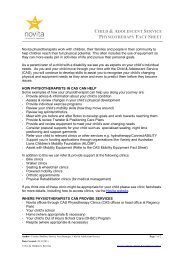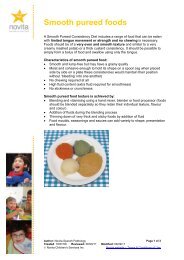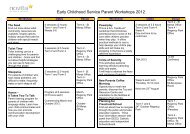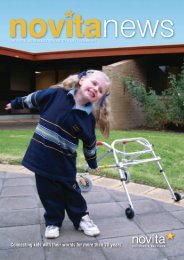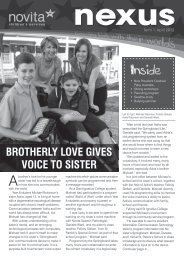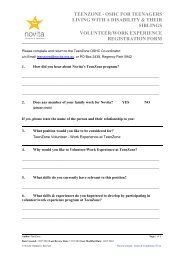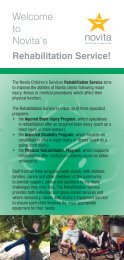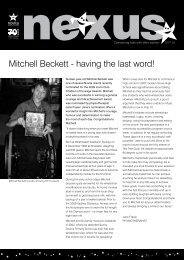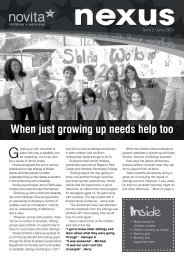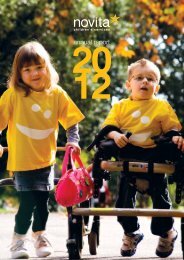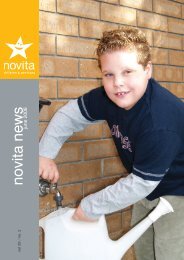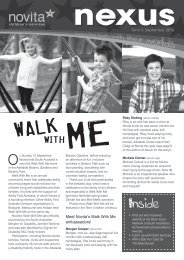Novita Research Report - 2004 to 2007 - Novita Children's Services
Novita Research Report - 2004 to 2007 - Novita Children's Services
Novita Research Report - 2004 to 2007 - Novita Children's Services
- No tags were found...
You also want an ePaper? Increase the reach of your titles
YUMPU automatically turns print PDFs into web optimized ePapers that Google loves.
77Project titleContribu<strong>to</strong>rsSummaryDeveloping an environmental testing pro<strong>to</strong>col for electronic assistive technologydevicesChris Hern (Flinders University), Dr Lloyd Walker, Jeff Price, David HobbsWhen you purchase a new device, you probably don’t immediately wonder ‘how durableis this, and will it break within the first few months of use?’ So if and when the device doesbreak, there is usually a feeling of disappointment and frustration, and time and energy iswasted returning the device <strong>to</strong> where it was purchased <strong>to</strong> have it repaired. The anger wouldprobably intensify if you discovered that your device broke because of a small componentfailure that could have been detected if it was tested prior <strong>to</strong> being sold.Currently, there is no Standard or formal procedure for testing the durability, environmentalconditioning or reliability of electronic assistive technology (AT) devices (such as speechgenerating devices). However, when electronic AT repair records are reviewed, commonfaults that occurred during normal use are detected. If a testing pro<strong>to</strong>col was available <strong>to</strong>type-test electronic AT devices, a benchmark could be set for an acceptable level of devicefunctionality and performance.The aim of this project was <strong>to</strong> research and develop a testing pro<strong>to</strong>col that outlines thenecessary procedures and tests that could be performed <strong>to</strong> ensure electronic AT devicesmeet the requirements and rigour of actual field use.MethodInvestigation in<strong>to</strong> common device failure was conducted <strong>to</strong> gauge the type of tests necessary<strong>to</strong> represent actual breakdown. An environmental pro<strong>to</strong>col or test suite was then developedthat summarised a number of International Electrotechnical Commission (IEC) EnvironmentalTesting Standards. The draft suite, consisting of 27 test Standards, identified the objectives,apparatus and procedures necessary <strong>to</strong> perform each test.The 27 tests, selected from a series of more than 60, were deemed <strong>to</strong> be the mostrepresentative of common device failures and likely environmental exposure. Some testswithin this suite include vibration, dust and sand, drop and <strong>to</strong>pple and fluid contamination.Staff from <strong>Novita</strong>Tech and <strong>Novita</strong> were surveyed with regard <strong>to</strong> the importance and relevanceof each test standard, in order <strong>to</strong> refine the suite so that the tests most representative offailures could be confirmed and included in the final test pro<strong>to</strong>col.ResultsA review of all <strong>Novita</strong>Tech Electronics Workshop repair records indicated that physicalbreakage, broken leads and connec<strong>to</strong>rs and the ingress of foreign matter were the mostcommon sources of failure for electronic AT devices. Touch screen failure and wear,component failure and circuit board corrosion were also among the common failings.The survey of key staff (including therapists who regularly prescribe electronic AT devicesand see the type of treatment they endure, plus technicians who regularly repair the devices)provided a ranking of the tests in order of importance. Of the 27 tests, seven were ranked‘very important’ (Group A), 10 as ‘important’ (Group B) and 10 as ‘not important/redundant’(Group C). This process refined the draft suite in<strong>to</strong> a document that could be circulatedamongst international peers working in Standard development.




